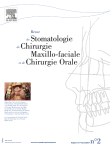Pendejo
Fire
- Joined
- Apr 15, 2019
- Posts
- 18,785
- Reputation
- 29,549

Posterior mandibular widening secondary to advancement sagittal split osteotomy: A retrospective study
Patients sometimes spontaneously report a modification of the width of their lower face after an advancement bilateral sagittal split osteotomy (ABSSO…
The first goal of the study was to assess the impact of ABSSO (advancement bilateral sagittal split osteotomy) on the BGD (bigonial distance), one day and one year after surgery. The second objective was to look for a possible relation between the increase of BGD and the amount of mandibular advancement.
All consecutive patients operated between August 2011 and October 2013 in our department for a class II malocclusion by mean of an isolated ABSSO were retrospectively included in the study. Concomitant wisdom tooth extraction was allowed. Patients operated with a combination of orthognathic procedures (ABSSO and mandibular contraction, and/or genioplasty, and/or Le Fort I maxillary osteotomy) and patients with incomplete records were excluded.
The technique used in the study was the Obwegeser-Dal Pont II technique.
Measurement methods
The amount of mandibular advancement was measured by comparison between pre- and postoperative lateral teleradiographies made in centric occlusal positionand taken one day and one year postoperatively. In order to be reproducible, measures were made between the anterior face of incisors or orthodontic brackets and projected on a horizontal axis (fig. 2).

Figure 2. Example of measures on lateral teleradiographies in centric occlusal position. A. Before surgery. B. Postoperative day 1 (radiological advancementhere is 7.362.45 = 4.91 mm).
The amount of posterior mandibular widening was assessed by measuring the variations of the BGD on frontal teleradio-graphies using the same chronology. Gonions were spotted as the most lateral points located on each mandibular angle (fig. 3).

Figure 3. Example of measures on frontal teleradiographies. A. Before surgery. B. Postoperative day 1. C. Postoperative year 1 (ICD = intercanthal distance;BGD = bigonial distance).
Intrinsic reliability was evaluated by measuring the medial intercanthal distance (ICD), considered as constant, on pre-operative and one day postoperative frontal teleradiographies (fig. 3).
Results
One day after surgery, BGD increased in all patients. Statistical analysis reported a significant mean increase of 9.8 mm(P<103). One year after surgery, mean BGD increase was 4 mm and remained significant compared with preoperative value(P<103). BGD decreased at one year postoperative in 9 patients (18%) comparatively to the preoperative measure. Schematic representation of all the BGD measures made by both evaluators shoved an ‘‘increase-decrease’’ profile (fig. 5).

Figure 5. Evolution of bigonial distance (BGD) measures for all the patients (black lines: measures made by investigator A; grey lines: measures made by investigator B).
Not significant relation was found between the amount of mandibular advancement and the postoperative variation of the BGD as shown by the absence of any specific pattern in the relation between these two variables (fig. 6).

Figure 6. Bigonial distance (BGD) evolution at one year postoperative according to mandibular advancement measured on lateral teleradiographies.

Figure 9. Clinical aspect of positive effect of lower face widening on a male patient. A. Before surgery. B. One year after surgery.
Discussion
BGD increase after ABSSO can first be explained by the anatomy. Because of the V-shape of the mandible, there will be an interference inside the osteotomy line during advancement of the dental arch, responsible for lateral displacement of the lateral valve on each side (fig. 7).

Figure 7. Schematic illustration of lateral movements of the lateral valves induced by dental arch advancement; superior view of the V-shaped mandible. Left: before advancement; right: after advancement.
The osteotomy technique may be of great importance in this phenomenon. In the technique described by Epker, residual lingual cortical bone on the lateral valve may interfere with the medial valve, responsible for a lateral flaring of the mandibular angles. The use of the Obwegeser-Dalpont II technique, may reduce these bony interferences, as the osteotomy is extended down to the basilar edge. The kind of fixation must also be considered. Semi-rigid fixation, might facilitate lateral flaring of mandibular angles. It would therefore be relevant to compare semi-rigid and rigid fixation. However, temporo-mandibular joint disorders seem to be more frequent when using rigid fixation techniques because of more severe modifications in condylar position induced by these devices.
Posterior mandibular widening seems to reduce one year aftersurgery, even if it remains significant. 9 patients(18%) showed a decrease in their posterior mandibular width at the one-year control. This was significantly observed in the youngest patients.
The hypothesis proposed in the study is that mandibular bone remodeling induced modifications in muscular strains is more important in young patients than in older ones.
Modifications induced by mandibular advancement on mus-cular strains and their effect on bone remodeling process mayexplain the decrease of posterior mandibular width one yearafter surgery in young patients.
TL;DR:
- Bigonial distance mean increase was 4mm after BSSO using the Obwegeser-Dal Pont II technique
- The bigonial distance decreased in some patients, especially on the younger ones.
- There was no relation between the amount of mandibular advancement and the increase of BGD.




